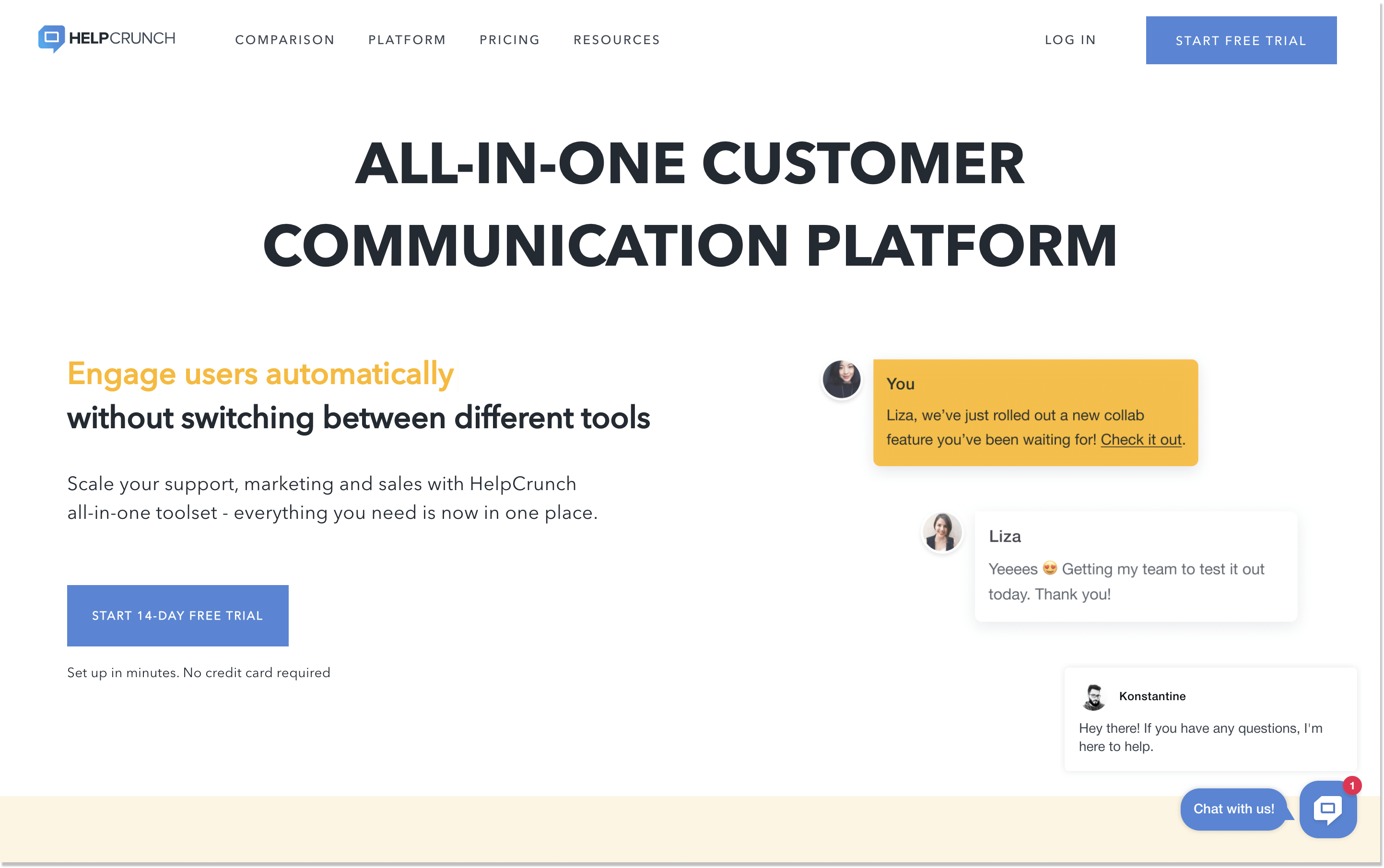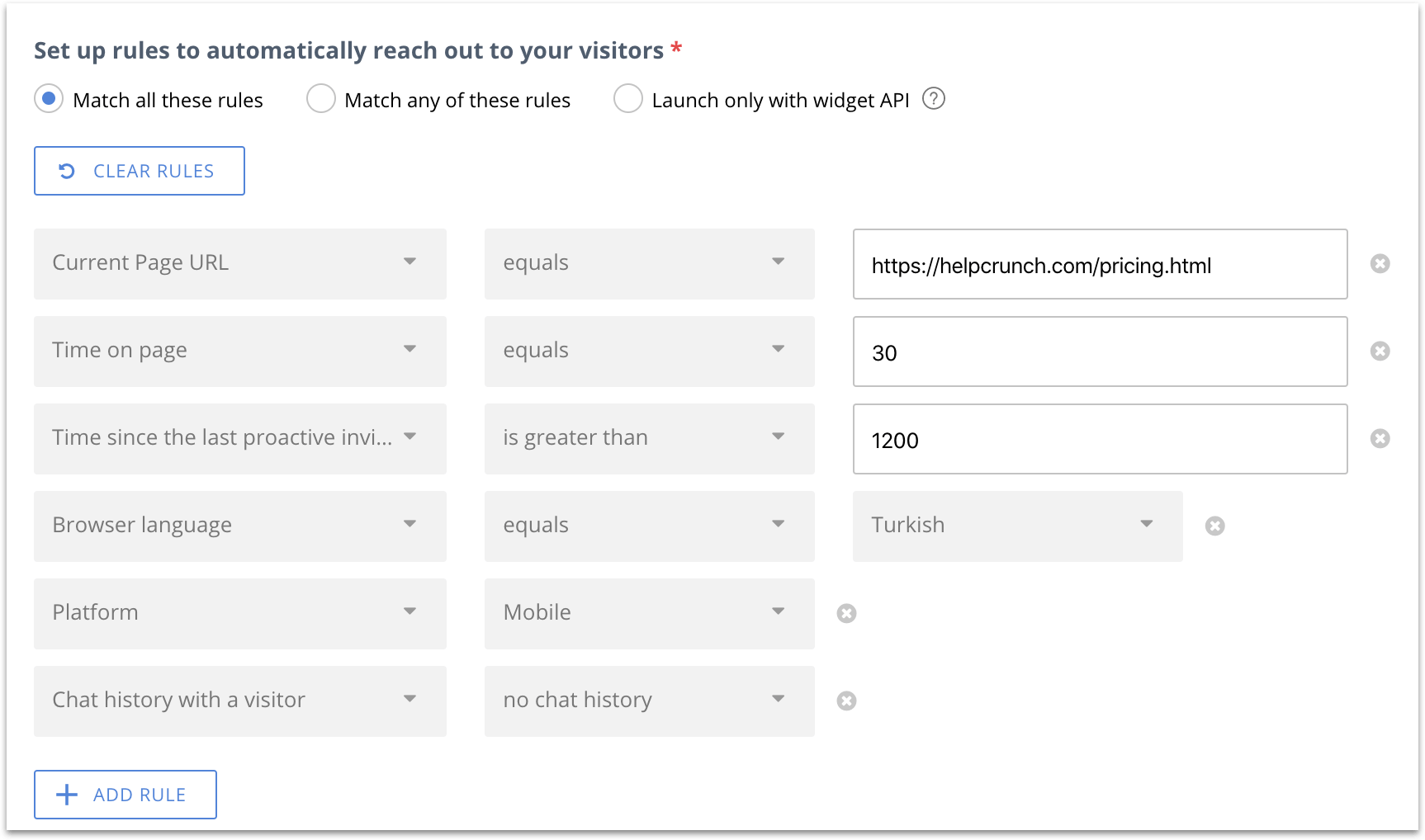7 Chat Triggers You Should Be Using on Your Website
Proactive chats are great for increasing customer engagement, but they require preciser chat triggers. Look at these 7 chat trigger examples that will make any automated message more enticing and effective.
Written by Anastasiia Khlystova

Live chat is one of the most popular communication channels among customers and businesses. It allows both sides to have real-time conversations, multitask, and speed up most of the tasks through different enhancements and automations.
One such enhancement is trigger-based proactive chat messages. Not all customers are equally eager to start a conversation. They may be browsing your website without any intention of buying your product. If a user wants to initiate a conversation themselves, they can do so through the live chat buttons on your website. However, if they aren’t willing to do so or are unsure about what type of consultation they want, proactive messages based on triggers will help nudge them.
Chat triggers are rules based on visitors’ personal info and behavior that activate corresponding contextual messages. Those chat messages are called ‘proactive auto messages’ and look like a regular message from a support agent.
For instance, when someone visits the HelpCrunch website for the first time, they see the following proactive greeting:

Proactive messages aim at establishing a dialogue. The ticket can then be closed or handled by a customer support agent if further assistance is required. Customer support agents can use canned messages – predefined responses to streamline their workflow.
What types of chat triggers are there?
Different customer service tools will offer your different chat triggers. However, one can distinguish 6 main types of data that you can base your website proactive messages on:
- Chat triggers based on specific pages
The very basis of every trigger-based chat message is WHERE you want to display it. Every website has strategic pages or problematic spots, so it makes much sense to offer help there proactively. Chat triggers based on specific pages allow you to do just that.
- Chat triggers based on the number of visits
There are visitors that land on your website accidentally to leave and never return. There are high-quality leads that keep returning there. And they require particular attention. By specifying the number of visits, you can have a personalized approach towards each of them.
- Chat triggers based on time
Sending proactive messages to visitors right after they appeared on your website is not the best idea. Let them look around for a minute or two, see what’s what on their own — and use the time they’ve spent on your website as a trigger for your proactive messages.
- Chat triggers based on user data
You can differentiate your trigger-based messages by users’ devices (mobile or desktop), countries, cities, and browser language. It’s a great way to add a small personalization touch.
- Chat triggers based on visitor’s exit intent
The ‘exit intent’ chat trigger detects the moment a visitor moves a mouse towards the back button and calls in a proactive message. Such a message can contain some last-minute offer that will stop people from leaving — a small discount or some free stuff.
- Chat triggers based on URL parameters
If you want to craft custom proactive messages for visitors from different sources, there are chat triggers for this, too. Reach out to visitors based on their source or referrer URLs. And if you’re using custom UTM parameters in your marketing campaigns, it’s possible to specify them as chat triggers, too.

7 chat trigger examples for your website
1. First visit
When a visitor lands on your website for the first time, they might even miss the fact that you have live chat support. That’s why it’s important to set trigger-based chat invitations that will let everyone know you’re available to talk.
Don’t be too pushy and don’t expect much. You just want to build that first bond and make a nice first impression.
Chat message examples:
- Hi there! Any questions? We’re here to help ?
- New here? Just look around and I’ll be here in case you need help.
Chat triggers:
- Current page URL -> contains -> [https://yourwebsite.com/]
- Time on page -> is greater than -> 20 seconds
- Number of visits -> equals -> 1
- Browser language -> equals -> [Specific language]
2. Repeat visit
The ‘first visit’ trigger is not going to convert a ton of high quality prospects for your website right away. People visit too many websites each day by mistake and leave them immediately.
But, if someone ends up on your website for the second or third time, chances are they know why they’re here. Greet your repeat visitors with more personalized offers letting them know their interest didn’t go by unnoticed.
You’ll be pleasantly surprised! Chat triggers based on the second or third visit usually show a higher percentage of open and reply rates.
Chat message examples:
- Glad to see you back! Can I help you with anything?
- Back again so soon? Things are getting serious ?Chat with us if you have any questions.
- Welcome back! We’re here to help as always.
Chat triggers:
- Number of visits -> equals -> 2
- Time on page -> is greater than -> 30 seconds
- Chat history with a visitor -> no chat history
- Browser language -> equals -> [Language]
3. Pricing page visit
If you’re a SaaS company, your pricing page is your most important strategic place. If a visitor made it there, things ARE pretty serious. So, you just can’t afford losing them there.
On the other hand, money issues require a careful diplomatic approach that you should show in your proactive chat message. Don’t push and don’t be too vague.
Chat message examples:
- Have any questions about our pricing? We can answer them all.
- Need help with choosing the best subscription plan for your business? Ask me!
- We’re here to answer any money-related questions in case you need help ?
Chat triggers:
- Current page URL -> equals -> [https://yourwebsite.com/pricing/]
- Time on page -> is greater than -> 30 seconds
4. Knowledge base visit
Even though businesses create knowledge bases with a sole purpose of providing customers with a self-service portal, you can’t just leave them alone.
There are two sides of the coin here. On one hand, 73% of consumers want to solve product/service issues on their own, and an extensive knowledge base plays a crucial role here. On the other hand, if they don’t find a satisfactory solution there, they’ll just leave.
But, you can use corresponding chat triggers to spot visitors who stay on your knowledge base page for too long and offer help.
Chat message examples:
- Didn’t find the solution to your issue? Chat with us.
- Nothing helpful here? Our support team is available and ready to assist.
Chat triggers:
- Current page URL -> equals -> [https://yourwebsite.com/knowledge-base/]
- Time on page -> is greater than -> 200 seconds
- Chat history with a visitor -> no chat history
5. Product page visit
Landing pages of all kinds are always crafted to convert as many visitors as possible. They usually have everything for this – a list of advantages you can get, tantalizing images, calming colors and clear calls-to-action everywhere.
What else could you possibly do to make them convert better? That’s right. You can reach out to visitors proactively and offer a helping hand or even cross-sell additional products.
Chat message examples:
- Hi ?Have questions about our [Product]? I’m here to answer them.
- Did you know that our [Product] can [Product’s benefit]? Chat for more details ?
- Hi! Did you know that [Product 2] is a perfect fit for [Product 1]. Chat for more details.
Chat triggers:
- Current page URL -> equals -> [https://yourwebsite.com/product/]
- Time on page -> is greater than -> 200 seconds
- Chat history with a visitor -> no chat history
6. Checkout page visit
E-commerce websites should pay particular attention to their checkout page. According to the Statista research, the global average shopping cart abandonment rate is 69.57%.
Just imagine! Only 30% of buyers end up buying stuff. And sure, every online store has an arsenal of cart abandonment emails, push notifications, and Facebook ads to run down those who left already.
However, timely helpful support can also play a crucial factor in buyers’ decisions. So, why not offer this support proactively on a checkout page. For instance, you can set proactive chats right after a buyer is caught on a checkout page or only target people who have been lingering there for some time.
The ‘exit intent’ chat trigger can be especially helpful. And if you can offer something extra like free delivery or a small discount, it would work wonders.
Chat message examples:
- Need help with finishing your order? I’m here to help.
- Not sure? Our team is ready to help you choose the most suitable product.
- Did you know that we currently offer free delivery on all our products?
Chat triggers:
- Current page URL -> equals -> [https://yourwebsite.com/checkout-page/]
- Time before exit intent -> is greater than -> 20 seconds
7. Special offers
A good marketer will use any opportunity to run a promo campaign. And a good customer support representative is always there to cover for them on the ground.
While marketers are busy running potential leads down with Facebook ads and newsletters, websites should be ready, too. Set up a few proactive chat messages on your website to remind customers once again what you offer and why they should take hold of it immediately.
For instance, if it’s a Black Friday campaign, you can greet visitors with proactive messages telling about your discounts.
Chat message examples:
- Greetings! Interested in our special offer? Chat for more information.
- It’s [Occasion] ? Don’t forget to use our special discounts today.
- Enjoy our [Occasion] offer! Want to chat first?
- Did you know that everyone who signs up today can get a [%] discount? ?
Chat triggers:
- UTM campaign -> contains -> [special_offer]
- Time on page -> is greater than -> 30 seconds
How to set up chat triggers for your website
All in all, you can target people who are staying for a specific period of time of a specific page with a personalized offer. You can anticipate when they’re going to leave and catch them before they do.

But, there are some universal rules that you can apply to your trigger-based messages:
- A proactive message can be based on several chat triggers simultaneously.
- You can choose to display them when your support team is either online or offline. If it doesn’t matter, just specify so and a chat message will pop up no matter what.
- It’s possible to target website visitors and your registered customers separately. If this attribute isn’t crucial, you can target both.
- Each message can be sent only once per user, or appear repeatedly each time a user meets the criteria you define with chat triggers.
Conclusion
Trigger-based chat messages are pretty great no matter which way you look at the matter. They can increase your user engagement and drive more potential leads. They’re less intrusive than popups and work quite great for offering proactive support. Basically, it’s a win-win situation for both parties.
But, in order for them to work, you need to study your customers’ behavior and gain insights into what they want. Only in this case, chat triggers will help you catch every valuable visitor and build strong relationships with them.
Eager to try? Sign up for HelpCrunch and go straight to its Auto messages functionality.





